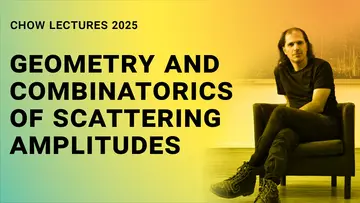Poster Session
Abstract
Kinematic Stratifications
Veronica Calvo CortesMPI MiS Leipzig, Germany
We study stratifications of regions in the space of symmetric matrices. Their points are Mandelstam matrices for momentum vectors in particle physics. Kinematic strata in these regions are indexed by signs and rank two matroids. Matroid strata of Lorentzian quadratic forms arise when all signs are non-negative. We characterize the posets of strata, for massless and massive particles, with and without momentum conservation.
Wilson Loop Correlators
An n-gluon scattering amplitude in N=4 SYM is equal to the expectation value of a light-like polygonal Wilson loop, <W>, with n sides (0705.0303, 0707.1153, 0707.0243, 1009.2225, 1101.1329). Thus, expectation values of light-like polygonal Wilson loops satisfy the properties of gluon scattering amplitudes. Scattering amplitudes display many interesting mathematical properties, such as BCFW recursion relations and generalised unitarity. These properties allow amplitudes to be expressed in a vastly simpler way than the Feynman diagram expansion. Motivated by the scattering amplitude-Wilson loop duality, we investigated whether Wilson loop correlators, <W_1 W_2 >, satisfy similar mathematical properties. In this poster, I will introduce these observables in twistor space and discuss some of their mathematical properties, such as the chiral box expansion, with coefficients given by tree-level correlators, the Q-bar equation, which relates loop-level correlators to correlators of lower loop order, and a tree-level BCFW relation. I will then briefly detail future directions, which will involve using these correlators to compute other observables in N=4 SYM.
Possibly: Vandermonde cells as positive geometries
We study Vandermonde cells from the perspective of positive geometry, determining canoncial forms in the planar case and proving an obstruction to the existence of canoncial forms in the non-planar case.
ML degrees for Hypertrees
The maximum likelihood degree (ML degree) is a positive integer one can attach to any algebraic variety, given by the number of critical points of the associated log-likelihood function. When a variety admits ML degree one, we call this "minimal kinematics." Particle physicists are particularly interested in subvarieties of complex tori parameterized by massless particle momenta, where the associated log-likelihood function is given by the scattering potential. By restricting to subspaces of kinematic space, one can reach ML degree one; this is an attractive scenario in which the unique critical point is rational in the kinematic data. Such choices of restrictions may be prescribed by combinatorial objects known as hypertrees, which can be viewed as on-shell diagrams and correspond to effective divisors on M_0,n. In this project, we investigate formulas for the ML degree of arbitrary hypertrees, as well as their associated divisors.
